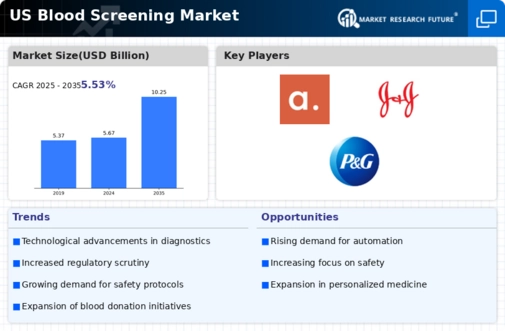Regulatory Changes and Compliance
The US blood screening market is heavily influenced by regulatory changes and compliance requirements set forth by agencies such as the Food and Drug Administration (FDA) and the Centers for Disease Control and Prevention (CDC). These regulations ensure that blood screening processes meet stringent safety and efficacy standards. Recent updates to guidelines have emphasized the need for enhanced screening protocols, particularly for emerging infectious diseases. Compliance with these regulations is not only crucial for maintaining public health but also for fostering trust in blood donation systems. The market is expected to see a rise in demand for compliance-related services and technologies, as organizations strive to adhere to these evolving standards. This regulatory landscape is likely to shape the operational strategies of blood screening facilities across the United States, thereby impacting the overall dynamics of the US blood screening market.
Growth of the Biotechnology Sector
The US blood screening market is poised for growth, largely fueled by the expansion of the biotechnology sector. Biotech companies are increasingly developing innovative screening technologies that enhance the detection of pathogens and other harmful agents in blood products. The integration of biotechnology into blood screening processes is expected to improve sensitivity and specificity, thereby ensuring higher safety standards. Moreover, collaborations between biotech firms and blood banks are becoming more common, facilitating the development of tailored screening solutions. The market is projected to benefit from these partnerships, as they enable the rapid introduction of cutting-edge technologies. As the biotechnology sector continues to thrive, it is likely to play a pivotal role in shaping the future landscape of the US blood screening market.
Rising Incidence of Infectious Diseases
The US blood screening market is facing a growing demand due to the rising incidence of infectious diseases. Conditions such as hepatitis, HIV, and West Nile virus continue to pose significant public health challenges. The Centers for Disease Control and Prevention (CDC) reports that the prevalence of these infections has led to an increased focus on effective blood screening methods. As the population ages and the incidence of chronic diseases rises, the need for comprehensive blood screening becomes even more critical. This trend is likely to drive investments in advanced screening technologies and methodologies, as healthcare providers seek to ensure the safety of the blood supply. Consequently, the US blood screening market is expected to expand as stakeholders respond to the pressing need for enhanced screening capabilities to combat the spread of infectious diseases.
Increased Public Awareness and Education
The US blood screening market is benefiting from a surge in public awareness and education regarding the importance of blood safety. Campaigns aimed at educating the public about the risks associated with blood transfusions and the role of screening in mitigating these risks have gained traction. According to recent surveys, approximately 70% of Americans are now aware of the significance of blood screening in preventing transfusion-transmitted infections. This heightened awareness is driving an increase in voluntary blood donations, which in turn necessitates more rigorous screening processes. Blood banks and healthcare organizations are investing in outreach programs to further educate the public, thereby enhancing the overall safety of the blood supply. As a result, the demand for blood screening services is likely to rise, positively influencing the growth trajectory of the US blood screening market.
Technological Advancements in Screening Methods
The US blood screening market is experiencing a notable transformation due to rapid technological advancements. Innovations such as nucleic acid testing (NAT) and next-generation sequencing (NGS) are enhancing the accuracy and speed of blood screening processes. For instance, NAT allows for the detection of viral infections at earlier stages, significantly reducing the window period for transfusion-transmitted infections. The market is projected to grow at a compound annual growth rate (CAGR) of approximately 6.5% from 2023 to 2030, driven by these advancements. Furthermore, automation in laboratories is streamlining workflows, thereby increasing efficiency and reducing human error. As a result, healthcare providers are increasingly adopting these advanced technologies, which is likely to bolster the overall growth of the US blood screening market.
















